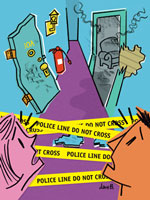HABITAT
Crisis Management
Fire, homicide, a structural collapse – when a crisis hits, a savvy board must show leadership to help tamp down panic. Here are "The Three Cs" that can help you do it, along with personal, first-hand accounts from board-members and building-managers who have had their own real-life trials by fire, and ice….
It’s over. The fire has been contained, the murder scene cordoned off, the ceiling cave-in stopped and temporary support beams put in place. Fortunately, you’d done your emergency preparedness (see "Emergency Preparedness,” Habitat, May 2006), and so your building’s computer files and paper documents had off-site backup.
What now? In the fog of confusion, the adrenaline rush, the worry and even the terror that can follow a fire, murder or other building-wide trauma, your residents need help, answers, reassurance and, most of all, a point-person.
“You have to be focused, single-minded, and stay calm because the people around you will play off how you react,” says Daniel Wollman, CEO of the management company Gumley Haft Kleier. “If you let yourself get hysterical, you’re going to make everyone around you hysterical.”
Your first step in dealing with a crisis and its aftermath is to follow what we call “The Three Cs”: communication, coordination and calm. If, in the middle of everything, you suddenly stop and realize, “Hey, I’m just a volunteer board-member. I’m not a professional crisis-manager. I’ve never done this before and what do I do now?," just think of those three Cs. They are the underlying principles that will guide you toward the right direction and the right choices.
1) Communication
You need to get information from an authoritative source and give information to your building’s residents.
“The first and most important thing is to deal with the crisis,” says Herbert D. Freedman, general counsel of Marion Scott Real Estate, the company that manages the 15,374-unit Co-op City complex in the northern Bronx. “The second is to let people know what’s going on. People need to know what’s happening and the trick is to get accurate information out as quickly as possible.”
In the case of a shooting rampage in August 2007 that left one Co-op City worker dead and three others wounded, management gave out information using both low- and high-tech communications – from simple flyers to a text-crawl on the residents’ closed-circuit security-camera TV channel.
“Be honest with people,” advises Lee J. Colan, president of The L Group leadership-training consultancy and author of Seven Moments that Define Excellent Leaders. “Provide clear, concise communication. We all have those thoughts of, ‘We’ll just tell them what they need to know,’ or ‘They won’t understand.’ But leaders who underestimate the intelligence of their constituents are generally overestimating their own.” Besides which, he adds: “If people don’t think you’re credible, you’ve undermined whatever leadership influence you might have had. Part of honesty is acknowledging what we know and what we don’t know.”




